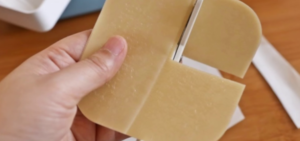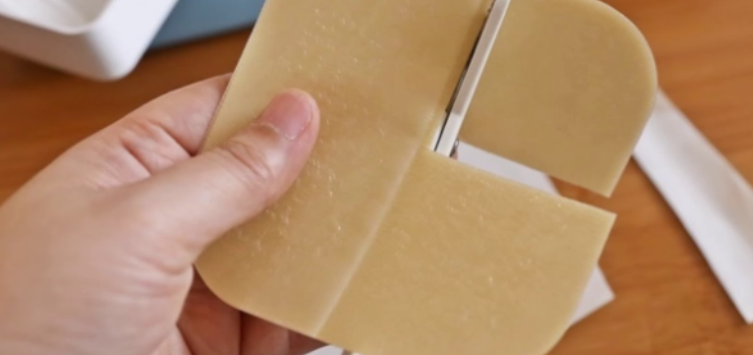By Nancy Morgan, RN, BSN, MBA, WOCN
Each month Nancy Morgan Wound Care brings you a tool you can apply in your daily practice
Support Resources:
Infographics: 12 Top Wound Dressings

Description
A hydrocolloid dressing is a wafer type of dressing that contains gel-forming agents in an adhesive compound laminated onto a flexible, water-resistant outer layer. Some may have formulations may contain an alginate to increase absorption capabilities. The wafers are self-adhering and available with or without an adhesive border and in various thicknesses and precut shapes for such body areas as the sacrum, elbows, and heels.
Actions
Hydrocolloid dressings are occlusive, so they provide
• Moist wound healing environment
• Autolytic debridement
• Insulation
Advantages
- Easy to apply
- Impermeable to bacteria and other contaminants
- Self-adherent and mold well
- May be used under compression products
- Extends wear time
Disadvantages
- Not recommended for wounds with heavy exudate, sinus tracts, or when infection is present
- Must be used with caution on the feet of patients with diabetes as may increase risk of infection due to occlusive properties by retaining bacteria/exudate.
Tips
Use on superficial wound with no signs of infection
Scant to moderate exudate
No signs or symptoms of ischemia
- Assessment can be difficult if the hydrocolloid dressing is opaque
• May become dislodged if the wound produces heavy exudate
• May curl or roll at the edges
• Upon removal, dressing residue may adhere to the wound bed and there may be an odor
• May cause periwound maceration
• May cause trauma/injury to fragile skin upon removal
• May cause hypergranulation
When to use
A hydrocolloid dressing is appropriate for these situations
• noninfected wound with scant to moderate drainage
• necrotic or granular wound
• dry wound
• partial- or full-thickness wound
• protection of intact skin or a newly healed wound.
Frequency of dressing changes
- Change the dressing every 3 to 7 days depending upon exudate and manufacturer guidelines.
- If daily dressing changes are required, reconsider the appropriateness of this approach because these dressings are designed for extended wear for up to 7 days.
How to apply a hydrocolloid dressing https://www.youtube.com/watch?v=3e0nx9ln-h8
- Wash your hands and put on gloves.
- Remove the soiled dressing (noting the date it was applied) and place it in a trash bag.
- Remove your gloves, wash your hands, and put on new gloves.
- Clean the wound with normal saline solution or prescribed cleanser.
- Use clean gauze to pat dry the tissue surrounding the wound.
- Remove your gloves, wash your hands, and put on new gloves.
- Apply liquid barrier film or moisture barrier to the periwound area.
- For deep wounds, apply wound filler or packing materials as indicated.
- Before applying the hydrocolloid dressing, warm it by holding it between your hands to increase adhesive ability.
- Remove the paper backing from the dressing.
- Gently fold the dressing in half lengthwise and apply it from the center of wound outward.
- Smooth the dressing in place from the center outward. Hold the dressing in place for a few seconds to improve adhesion.
- The dressing should be at least 1 inch larger than the wound. (Some manufacturers may require a 2-inch border.)
- You may apply tape around the edges to secure the dressing.
- Dispose of the waste.
- Remove your gloves and discard.
How to remove a hydrocolloid dressing
- Press down on the skin and carefully lift an edge of the dressing. Continue lifting around the dressing until all adhesive edges are free.
- Gently peel away the dressing from the skin in the direction of the hair growth.
Selected References
- Complete Guide For Hydrocolloid Dressing. (2016, November 23). Wound Care Society. Retrieved from Complete Guide For Hydrocolloid Dressing – Wound Care Society
- Kothari, Anushree. All you need to know about Hydrocolloid Dressings. (2019, Jan 4). HPFY.
- Hess, Cathy Thomas, RN, BSN, CWCN. (2019). Product Guide to Skin & Wound Care. 8th ed. Philadelphia, PA: Lippincott Williams & Wilkins.
Nancy Morgan RN, BSN, MBA, WOCN is an experienced clinician, successful business leader, and accomplished nurse educator in the field of wound management. She is the co-founder of the Wound Care Education Institute, (WCEI®), Wild on Wounds Productions; and, most recently established Nancy Morgan Wound Care offering innovative, educational resources including seminars, webinars, social media and wound care marketing tools to assist and support wound care clinicians at the bedside. Nancy is one of the most distinguished wound care educators, delivering nearly 1200 lectures, conference keynote addresses, seminars, webinars, and bedside consultations during her career.
Information is courtesy of Nancy Morgan Wound Care, copyright 2022.
DISCLAIMER: All clinical & legal information, text and graphics, in this blog are intended to assist with determining appropriate wound therapy or proper legal information. It is not intended to be a substitute nor constitute providing legal or medical care or advice, diagnosis, or treatment. Responsibility for final decisions and actions related to legality and care of specific patients shall remain the obligation of the institution, its staff, and the patients’ attending physicians and their legal representation. Individuals should always contact their healthcare providers for medical or emergency-related care and/or contact their retained attorneys or their legal representation.



